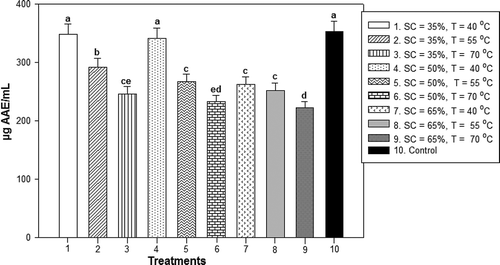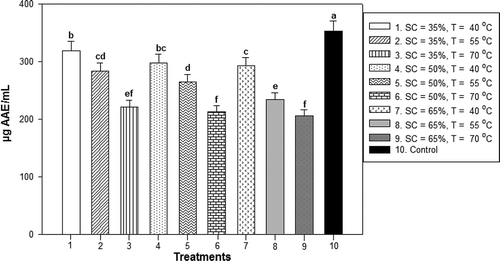Figures & data
Figure 1. Experimental and simulated kinetics of WL during ginger OD using: (a) 35%, (b) 50% and (c) 65% sucrose solution with and without blanching at different temperatures.
Figura 1. Cinéticas experimentales y simuladas de la pérdida de agua durante la deshidratación osmótica de jengibre usando: (a) 35%, (b) 50% y (c) 65% de solución de sacarosa con y sin escaldado a diferentes temperaturas.

Figure 2. Experimental and simulated kinetics of SG during ginger OD using: (a) 35%, (b) 50% and (c) 65% sucrose solution with and without blanching at different temperatures.
Figura 2. Cinéticas experimentales y simuladas de la ganancia de sólidos durante la deshidratación osmótica de jengibre usando: (a) 35%, (b) 50% y (c) 65% de solución de sacarosa con y sin escaldado a diferentes temperaturas.

Figure 3. AC obtained of unblanched ginger and osmotically dehydrated with sucrose concentrations of 35%, 50% and 65% at temperatures of 40°C, 55°C and 70°C.Notes: * Data are expressed as mean ± standard derivation of three determinations. Different letters in the same column indicate significant difference (P < 0.05). SC = Sucrose concentration and T = Temperature.
Figura 3. Capacidad antioxidante obtenida de jengibre sin escaldar y deshidratado osmóticamente con concentraciones de sacarosa de 35, 50 y 65% a temperaturas de 40, 55 y 70°C.

Table 1. Effective diffusivity of water (Dew) in ginger with and without blanching using sucrose at different concentrations and temperatures.
Tabla 1. Difusividad efectiva de agua (Dew) en jengibre con y sin escaldado usando sacarosa a diferentes concentraciones y temperaturas.
Table 2. Effective diffusivity of solid (Des) in ginger with and without blanching using sucrose at different concentrations and temperatures.
Tabla 2. Difusividad efectiva de sólido (Des) en jengibre con y sin escaldado usando sacarosa a diferentes concentraciones y temperaturas.
Table 3. Experimental results of L*, C*, h°and ΔE in ginger with and without blanching and osmotically dehydrated with sucrose (35%, 50% and 65%) and temperature at 40°C, 55°C and 70°C.
Tabla 3. Resultados experimentales de L*, C*, h° y ΔE en jengibre con y sin escaldado y deshidratado osmóticamente con sacarosa (35, 50 y 65%) y temperatura a 40, 55 y 70°C.
Table 4. TPC obtained with and without blanching ginger and osmotically dehydrated with sucrose (35, 50 and 65%) and temperatures at 40, 55 and 70°C.
Tabla 4. Contenido total de polifenoles obtenido con y sin escaldado del jengibre y deshidratado osmóticamente con sacarosa (35, 50 y 65%) y temperaturas a 40, 55 y 70°C.
Figure 4. AC obtained of blanched ginger osmotically dehydrated with sucrose concentrations of 35%, 50% and 65% at temperatures of 40°C, 55°C and 70°C.Note: * Data are expressed as mean ± standard derivation of three determinations. Different letters in the same column indicate significant difference (P < 0.05). SC = Sucrose concentration and T = Temperature.
Figura 4. Capacidad antioxidante obtenida de jengibre escaldado y deshidratado osmóticamente con concentraciones de sacarosa de 35, 50 y 65% a temperaturas de 40, 55 y 70°C.

